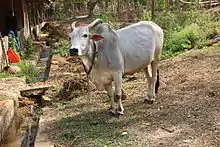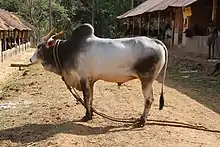Krishna Valley
The Krishna Valley is an Indian breed of draught cattle.[3] It originated in the areas drained by the Krishna, Ghataprabha and Malaprabha rivers. It is a recently-created breed, bred in the late nineteenth century as a draught animal for agricultural purposes.
 | |
| Conservation status |
|
|---|---|
| Country of origin | India |
| Distribution | northern Karnataka |
| Use | draught |
| Traits | |
| Weight | |
| Height | |
| Coat | greyish white |
| Horn status | horned |
| |

History
The Krishna Valley is a relatively modern breed. It was bred from about 1880 by the Mahratta Rajas of the southern part of Hyderabad State (now Maharashtra). A local breed known as Gaonti was cross-bred with Gir, Kankrej and Ongole, with selection for the power and size needed to plough the sticky soil of the valleys of the Krishna River and its tributaries such as the Ghatprabha and the Malaprabha.[2]:222[3][4]:98 Its range included the districts of Sangli, Satara and Solapur in Maharashtra, and of Belgaum, Bijapur and Raichur in Karnataka.[5] The Rao of Sangli was a noted breeder of these cattle.[4]:98
In 1946 the total breed population was estimated to be approximately 650 000; by 2012 it was believed that the number had fallen below 1000 head.[2]:222 The range of the breed has contracted, and it is now found only in northern Karnataka,[5] in the districts of Bagalkot, Belgaum and Bijapur. A breed conservation programme was started in the early twenty-first century. Semen was collected from eight selected bulls; more than 4000 doses were used for artificial insemination, and another 8000 doses were frozen for conservation in the gene bank of the National Bureau of Animal Genetic Resources.[6][7] A small conservation herd is kept at Bangalore.[2]:222
Use
The Krishna Valley was bred for heavy draught work, both for ploughing agricultural land and for the transport of crops such as cotton and sugar cane. It was among the zebuine breeds used in the creation of the American Brahman composite breed.[8]:192
References
| Wikimedia Commons has media related to Krishna Valley cattle. |
- Barbara Rischkowsky, D. Pilling (eds.) (2007). List of breeds documented in the Global Databank for Animal Genetic Resources, annex to The State of the World's Animal Genetic Resources for Food and Agriculture. Rome: Food and Agriculture Organization of the United Nations. ISBN 9789251057629. Accessed January 2017.
- Valerie Porter, Lawrence Alderson, Stephen J.G. Hall, D. Phillip Sponenberg (2016). Mason's World Encyclopedia of Livestock Breeds and Breeding (sixth edition). Wallingford: CABI. ISBN 9781780647944.
- Marleen Felius (1995). Cattle Breeds: An Encyclopedia. Doetinchem, Netherlands: Misset. ISBN 9789054390176.
- N.R. Joshi, R.W. Phillips (1953). Zebu cattle of India and Pakistan. FAO agricultural studies, number 19. Rome: Food and Agriculture Organization of the United Nations.
- S.M.K. Karthickeyan, R. Saravanan, P. Thangaraju (2006). Characterization of Krishna Valley breed of cattle (Bos indicus) in south India using microsatellite markers. Livestock Research for Rural Development 18 (11).
- Revival of Krishna Valley cattle breed. Indian Council of Agricultural Research. Archived 25 January 2012.
- Krishna Valley. Ankush – Environmental Protection Organization/Suvarnapuri Vaidika Gosamrakshana Seva Kendra. Archived 20 October 2018.
- Hilton Marshall Briggs, Dinus M. Briggs (1980). Modern Breeds of Livestock, fourth edition. New York: Macmillan. ISBN 9780023147302.
